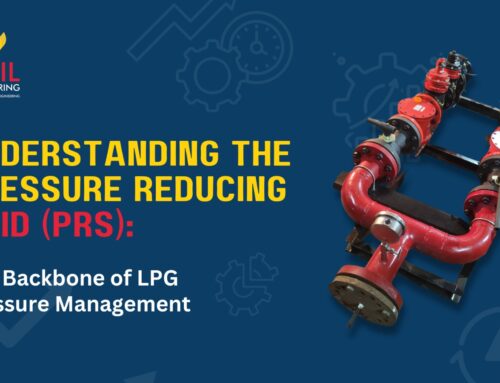In this series, I will discuss the terms “Volatile” and “Volatility”.
A liquid that emits vapour or can easily convert into vapour at normal temperature and pressure is called a volatile liquid. If a volatile liquid is kept in an open container, it will evaporate, and the vapour will disperse into the surrounding atmosphere. LPG is an example of a volatile liquid. Those working with LPG must have seen the liquid evaporating vigorously whenever liquid drops come in contact with the open air.
Petrol is also a volatile liquid; you can see petrol vapour around the filling nozzle at petrol pumps. However, diesel is less volatile than petrol, and petrol is less volatile than LPG. Butane is less volatile than propane in LPG mixtures.
Volatility measures the liquid’s volatility, which is important to the user. The liquid itself does not burn, but the vapour burns when mixed with enough air. For efficient burning, the fuel must easily convert to vapour and mix properly with air. Air supplies the oxygen required for burning. To ensure proper volatility of LPG, relevant specifications mention this property value. In India, IS 4576 specifies the quality requirements of LPG supplied to consumers. It mentions that the volatility should be 95% at 2°C for Butane and Propane-butane mixture. For propane, it should be 95% at −38°C. In all cases, the pressure should be 760mm Hg (atmospheric).
LPG in Automobiles
Note that for LPG used in automobiles, there is a separate specification, IS 14861, which does not mention volatility. However, it mentions that Evaporation Residue should not exceed 100mg/kg.
Liquid droplets in vapour can create problems for burners, so proper control of the volatility of the fuel is important. Liquid LPG expands approximately 250 times when it becomes vapour in an open atmosphere. A liquid with a lower boiling point is more volatile than a liquid with a higher boiling point. Propane has a boiling point of -42°C, and butane has a boiling point of -1°C. This is why propane is more volatile than butane. Both are considered highly volatile, and volatility increases with the temperature of the liquid.
To increase the vapour formation rate, one way is to heat the liquid in a vaporizer. As the container temperature increases, more vapour formation takes place. Sufficiently high pressure is maintained in the container at high ambient temperatures. Low-pressure problems may arise during nights and in winter, but things work fine during the daytime and in summer.
When vapour is withdrawn from the container, it may be propane-rich initially but not pure propane. When used as fuel, it does not matter much, as the calorific values of propane and butane are almost the same. However, if LPG is used for heat treatment purposes, such as creating a protective surface coating, a change in vapour composition can pose problems since the carbon content of the two (C3 and C4) is different. In such cases, a small vaporizer may be needed to take the liquid and evaporate it to get vapour.
Volatile Liquids and Vapour
One thing to note is that volatile liquids always have their surface surrounded by vapour, which keeps dispersing in the nearby atmosphere. The higher the volatility, the higher the chance of a high concentration of vapour in the surrounding atmosphere. If the concentration reaches the flammability range, the chances of ignition increase. Therefore, any possibility of leakage or spillage of liquid LPG must be eliminated entirely.
Flammable Gas and Flammability Range
Both terms are commonly used in technical documents and codes as part of standard terminology.
The word “flammable” means something that can burn, and interestingly, “inflammable” mean the same thing despite the addition of the prefix “in-“. This differs from words like sufficient and insufficient or adequate and inadequate, where the prefix changes the meaning to the opposite.
To ignite a substance, three elements must come together: a flammable substance, oxygen (air), and a flame (spark). This is what we learn from the fire triangle. It is the vapour of the substance that mixes with air, and when this mixture comes in contact with a flame, it ignites and starts burning. The minimum quantity of flammable vapour required to start burning is expressed as a percentage volume of the flammable vapour in the mixture, known as the Lower Explosive Limit (LEL).
If less than the LEL volume of vapour is present in the mixture, the mixture is called a “lean mixture” and will not ignite. Conversely, if more vapour is available in the mixture than the Upper Explosive Limit (UEL), the gas will not ignite, and this mixture is called a “rich mixture.” The terms LFL (Lower Flammability Level) and UFL (Upper Flammability Level) are also used to describe these limits.
The definition of “Flammable compressed gas” according to SMPV rules is “gas 13% or less of which when mixed with air forms a flammable mixture or whose flammable range with air is greater than 12%”. The values for LEL and UEL for Butane and Propane fit this definition, as they are both less than 13%. Methane is also a flammable gas, with an LEL of less than 13%, even though its UEL is more than 13%.
The flammability range is defined as the difference between the minimum and maximum percentage by volume of gas in a mixture with air that forms a flammable mixture at atmospheric pressure and ambient temperature. Ammonia and Hydrogen are highly flammable gases that fit this definition, while CO2 and N2 are non-flammable gases. Oxygen is not a flammable gas; however, it supports burning and can be very explosive if it comes in contact with any oily substance.
To ensure safety, installing leak detectors that give an alarm when a certain percentage of LEL of flammable gas is present in the atmosphere is essential. It is also important to note that the term “combustible substance” has the same meaning as flammable, but it is used for substances that can only burn higher than ambient temperatures. The flashpoint is the criteria that come into play for combustible substances, which will be discussed in a future article.



